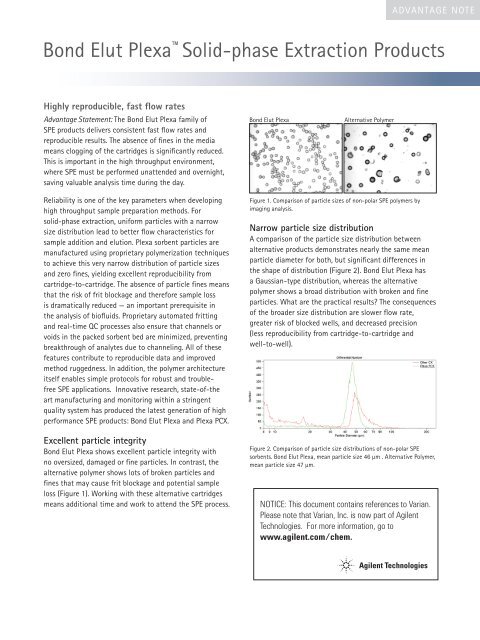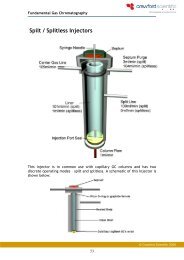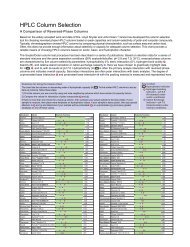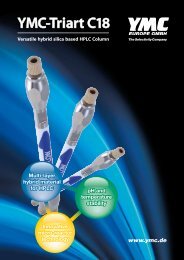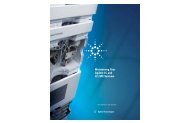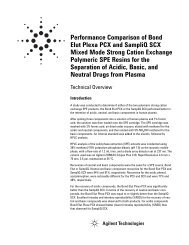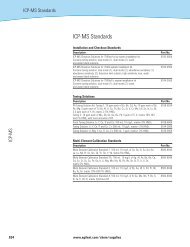Bond Elut Plexa™ Solid-phase Extraction Products - Crawford ...
Bond Elut Plexa™ Solid-phase Extraction Products - Crawford ...
Bond Elut Plexa™ Solid-phase Extraction Products - Crawford ...
You also want an ePaper? Increase the reach of your titles
YUMPU automatically turns print PDFs into web optimized ePapers that Google loves.
ADVANTAGE NOTE<br />
<strong>Bond</strong> <strong>Elut</strong> Plexa <strong>Solid</strong>-<strong>phase</strong> <strong>Extraction</strong> <strong>Products</strong><br />
Highly reproducible, fast flow rates<br />
Advantage Statement: The <strong>Bond</strong> <strong>Elut</strong> Plexa family of<br />
SPE products delivers consistent fast flow rates and<br />
reproducible results. The absence of fines in the media<br />
means clogging of the cartridges is significantly reduced.<br />
This is important in the high throughput environment,<br />
where SPE must be performed unattended and overnight,<br />
saving valuable analysis time during the day.<br />
Reliability is one of the key parameters when developing<br />
high throughput sample preparation methods. For<br />
solid-<strong>phase</strong> extraction, uniform particles with a narrow<br />
size distribution lead to better flow characteristics for<br />
sample addition and elution. Plexa sorbent particles are<br />
manufactured using proprietary polymerization techniques<br />
to achieve this very narrow distribution of particle sizes<br />
and zero fines, yielding excellent reproducibility from<br />
cartridge-to-cartridge. The absence of particle fines means<br />
that the risk of frit blockage and therefore sample loss<br />
is dramatically reduced — an important prerequisite in<br />
the analysis of biofluids. Proprietary automated fritting<br />
and real-time QC processes also ensure that channels or<br />
voids in the packed sorbent bed are minimized, preventing<br />
breakthrough of analytes due to channeling. All of these<br />
features contribute to reproducible data and improved<br />
method ruggedness. In addition, the polymer architecture<br />
itself enables simple protocols for robust and troublefree<br />
SPE applications. Innovative research, state-of-the<br />
art manufacturing and monitoring within a stringent<br />
quality system has produced the latest generation of high<br />
performance SPE products: <strong>Bond</strong> <strong>Elut</strong> Plexa and Plexa PCX.<br />
Excellent particle integrity<br />
<strong>Bond</strong> <strong>Elut</strong> Plexa shows excellent particle integrity with<br />
no oversized, damaged or fine particles. In contrast, the<br />
alternative polymer shows lots of broken particles and<br />
fines that may cause frit blockage and potential sample<br />
loss (Figure 1). Working with these alternative cartridges<br />
means additional time and work to attend the SPE process.<br />
<strong>Bond</strong> <strong>Elut</strong> Plexa Alternative Polymer<br />
Figure 1. Comparison of particle sizes of non-polar SPE polymers by<br />
imaging analysis.<br />
Narrow particle size distribution<br />
A comparison of the particle size distribution between<br />
alternative products demonstrates nearly the same mean<br />
particle diameter for both, but significant differences in<br />
the shape of distribution (Figure 2). <strong>Bond</strong> <strong>Elut</strong> Plexa has<br />
a Gaussian-type distribution, whereas the alternative<br />
polymer shows a broad distribution with broken and fine<br />
particles. What are the practical results? The consequences<br />
of the broader size distribution are slower flow rate,<br />
greater risk of blocked wells, and decreased precision<br />
(less reproducibility from cartridge-to-cartridge and<br />
well-to-well).<br />
Figure 2. Comparison of particle size distributions of non-polar SPE<br />
sorbents. <strong>Bond</strong> <strong>Elut</strong> Plexa, mean particle size 46 µm . Alternative Polymer,<br />
mean particle size 47 µm.
<strong>Bond</strong> <strong>Elut</strong> Plexa <strong>Solid</strong>-<strong>phase</strong> <strong>Extraction</strong> <strong>Products</strong><br />
<strong>Bond</strong> <strong>Elut</strong> Plexa<br />
Acidic<br />
Method optimized for acids<br />
1. Condition: 500 µL CH 3 OH, followed by 500 µL water<br />
2. Apply 100 µL plasma diluted 1:3 with 1% formic acid<br />
3. Wash: 500 µL 5% CH 3 OH<br />
4. <strong>Elut</strong>e: 500 µL CH 3 OH<br />
Simple protocols<br />
<strong>Bond</strong> <strong>Elut</strong> Plexa<br />
<strong>Bond</strong> <strong>Elut</strong> Plexa, the non-polar polymer, is universally<br />
applicable and the best choice for the extraction of a wide<br />
range of acidic, neutral and basic analytes from different<br />
matrices.<br />
<strong>Bond</strong> <strong>Elut</strong> Plexa PCX<br />
<strong>Bond</strong> <strong>Elut</strong> Plexa PCX is a cation exchanger with mixedmode<br />
sorbent characteristics and therefore suitable for<br />
the extraction and clean-up of weak bases from biofluids.<br />
<strong>Bond</strong> <strong>Elut</strong> Plexa PCX demonstrates the same excellent<br />
distribution and outstanding particle integrity as <strong>Bond</strong><br />
<strong>Elut</strong> Plexa. A highly controlled sulfonation process results<br />
in zero fines for <strong>Bond</strong> <strong>Elut</strong> Plexa PCX. Figure 3 shows the<br />
general protocol for trouble-free SPE applications with<br />
either <strong>Bond</strong> <strong>Elut</strong> Plexa or <strong>Bond</strong> <strong>Elut</strong> Plexa PCX.<br />
Faster flow rates and no clogging<br />
The practical effect of particle integrity on flow rate is<br />
shown in Figure 4. To compare flow rates between Plexa<br />
PCX and another CX polymeric sorbent, 12 wells were<br />
conditioned with 500 µL methanol followed by 500 µL<br />
of water. Plasma, diluted to 1:3 with phosphoric acid,<br />
was then added to every well, and a constant vacuum of<br />
5 in. Hg was applied. The time was recorded, enabling<br />
flow rates to be calculated.<br />
Neutral<br />
Method optimized for bases and neutrals<br />
1. Condition: 500 µL CH 3 OH, followed by<br />
500 µL water<br />
2. Apply 100 µL plasma diluted 1:3 with<br />
2% NH 3<br />
3. Wash: 500 µL 5% CH 3 OH<br />
4. <strong>Elut</strong>e: 500 µL CH 3 OH<br />
Plexa PCX<br />
Basic<br />
Mixed-mode method optimized for bases<br />
1. Condition: 500 µL CH OH, followed by 500 µL water<br />
3<br />
2. Apply 100 µL plasma diluted 1:3 with 2% H PO 3 4<br />
3. Acidic wash: 500 µL aqueous 2% formic acid<br />
4. Neutral Wash: 500 µL CH OH-CH CN (1:1, v/v)<br />
3 3<br />
5. <strong>Elut</strong>e: 500 µL CH OH-CH CN + 5 % NH (28-30%)<br />
3 3 3<br />
Figure 3. General acid/basic screening using <strong>Bond</strong> <strong>Elut</strong> Plexa and Plexa PCX. Indicated volumes are based on <strong>Bond</strong> <strong>Elut</strong> 96 Plexa 10 mg plate.<br />
For SPE cartridges, elution volume should be 1-2 mL, with higher volumes for less polar analytes.<br />
Flow rate (mL/min)<br />
0.8<br />
0.7<br />
0.6<br />
0.5<br />
0.4<br />
0.3<br />
0.2<br />
0.1<br />
0<br />
1 2 3 4 5 6 7 8 9 10 11 12<br />
Well Number<br />
Figure 4. Plexa PCX (blue) demonstrates faster and more reproducible<br />
flow rates. Mean flow rate for Plexa PCX = 0.47 mL/min (%RSD = 24%),<br />
alternative CX polymer mean flow rate = 0.27 mL/min (%RSD=38%).<br />
Typical properties<br />
Parameters <strong>Bond</strong> <strong>Elut</strong> Plexa <strong>Bond</strong> <strong>Elut</strong> Plexa PCX<br />
Pore size (nominal) 120 Å 120 Å<br />
Particle size 45 µm 45 µm<br />
Specific surface<br />
area m2 /g<br />
450 m2 /g 450 m2 /g<br />
pH range stability 1-14 1-14<br />
Chemical resistance<br />
(solvents)<br />
Retention capacity<br />
/ Ion exchange<br />
capacity<br />
Broad range of protic<br />
and non-protic polar<br />
and non-polar solvents<br />
10% of sorbent mass*<br />
Broad range of protic<br />
and non-protic polar<br />
and non-polar solvents<br />
Cation exchange<br />
loading of 1.0 mmol/g<br />
(determined by<br />
elemental analysis of<br />
sulfur content)<br />
*highly dependent on matrix type and specific analyte characteristics<br />
These properties are characteristic but do not constitute specifications.<br />
PCX<br />
Other CX Polymer
<strong>Bond</strong> <strong>Elut</strong> Plexa <strong>Solid</strong>-<strong>phase</strong> <strong>Extraction</strong> <strong>Products</strong><br />
Conclusion<br />
Higher bed packing efficiency in an SPE device is achieved<br />
if the sorbent particles have a very narrow size distribution.<br />
This leads to higher performance. SPE sorbents that contain<br />
a large degree of fines will cause blockage of the sample<br />
and lead to a slow, variable flow of solvent and analyte<br />
through the sorbent bed. Thus, assay variability with respect<br />
to recovery rates will increase.<br />
<strong>Bond</strong> <strong>Elut</strong> Plexa sorbent particles are nearly mono-dispersed<br />
in size, resulting in a very homogeneous packing. Therefore,<br />
reproducible results with excellent recoveries and sharp<br />
elution profiles are the standard. <strong>Bond</strong> <strong>Elut</strong> Plexa products<br />
are highly amenable to a high throughput or automated<br />
platforms due to excellent well-to-well and cartridge-tocartridge<br />
flow reproducibility.<br />
Varian, Inc.<br />
www.varianinc.com<br />
North America: 800.926.3000, 925.939.2400<br />
Europe The Netherlands: 31.118.67.1000<br />
Asia Pacific Australia: 613.9560.7133<br />
Latin America Brazil: 55.11.3238.0400<br />
Other sales offices and dealers throughout the world _ check our Web site.<br />
Chromatography • Spectroscopy • Mass Spectrometry • Magnetic Resonance Spectroscopy and Imaging • X-Ray Crystallography • Dissolution • Consumables • Data Systems • Vacuum<br />
<strong>Bond</strong> <strong>Elut</strong> Plexa, Varian, the Varian logo and the Varian Care logo are trademarks or registered trademarks of Varian, Inc. in the U.S. and<br />
other countries. © 2009 Varian, Inc.<br />
SI-1935 04/09 Printed in U.S.A.


